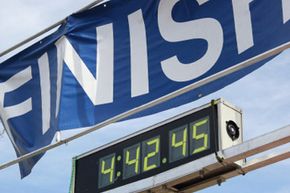Finishing a marathon is an achievement that requires discipline, desire and lots of preparation. Think of it as the athletic equivalent of getting a college degree. It doesn't come easy. And, like a transcript with a corresponding grade point average, marathoners want written proof that they've finished with that all-important number -- their finish time. It's evidence of a job well done.
The system of providing marathoners with their respective finish times has changed a great deal over the years. That's partially due to the increasing number of people attempting to complete the 26.2-mile race. In the past three decades, the ranks of people who have completed a marathon in a given year have swelled from less than 150,000 to 425,000 [source: Hamann]. It's more challenging to record the finish times of thousands of people in a single race, as opposed to just a few dozen runners.
Advertisement
Advances in technology have also made it possible to offer amenities to runners and spectators they couldn't have conceived of during the age of clipboards and stopwatches. Thanks to high-tech timing systems, a runner can review his or her split times after a race to determine what sections were run too fast or too slow. And not only that -- family members and friends can get real-time alerts indicating, for example, when their favorite runner crosses the mid-way point. In some cases, the alerts will even indicate where the runner is in relation to a local coffee shop or burger joint and when they're expected to cross the finish line [source: Bank of America Chicago Marathon].
Of course, as any early adopter will tell you, technology has its pitfalls. Some timing systems have failed with irritating and disappointing results [source: MacInnis]. Tweaks and upgrades continue to be made in the timing industry, even as marathoners adjust their training plans and improve their physical fitness.
So, how tough can timing a marathon be? And how does it benefit the runner? Consider the net times.
Advertisement



